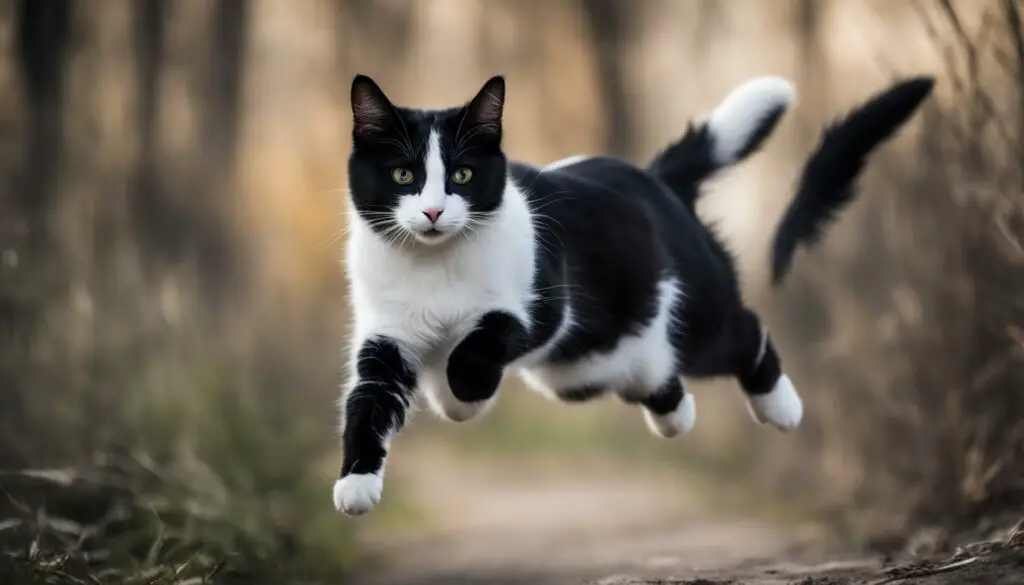Have you ever marveled at the incredible athleticism and agility of cats? Their breathtaking jumps and acrobatic feats never cease to amaze. From leaping onto high surfaces to effortlessly clearing obstacles, cats showcase their nimble and athletic abilities in ways that leave us in awe.
In this article, we will delve into the world of cat jumps and explore the fascinating heights these feline athletes can reach. We will uncover the secrets behind their amazing jumps, from the physics and science behind their leaps to the anatomy that contributes to their exceptional skills. Get ready to be amazed as we unravel the mysteries of cat jumping!
Key Takeaways:
- Cats possess remarkable agility and athleticism, allowing them to perform stunning jumps.
- Their jumps are powered by powerful leg muscles and flexible spines.
- Cats use their jumps to catch prey and escape from predators.
- Their paws, claws, and balance play a crucial role in executing flawless landings.
- Some cat breeds are known for their exceptional jumping skills.
The Physics Behind Cat Jumping
Cat jumping is a remarkable display of athleticism that never fails to leave us in awe. But have you ever wondered about the science behind these astonishing jumps?
When a cat jumps, it relies on a combination of athleticism and physics to propel itself into the air. The key to their impressive jumps lies in the powerful muscles in their hind legs and their flexible spines. As they spring forward, their muscles generate the force needed to propel them upwards, allowing them to achieve impressive altitudes.
But it’s not just brute strength that enables cats to jump so high. Their agile bodies play a crucial role as well. Cats possess the ability to adjust their trajectory mid-jump, allowing them to fine-tune their movements and reach even greater heights. This flexibility, combined with their powerful muscles, gives them an unparalleled ability to soar through the air.
| Key Factors in Cat Jumping | Explanation |
|---|---|
| Powerful Leg Muscles | Their strong hind leg muscles generate the force needed to achieve impressive heights. |
| Flexible Spines | Their flexible spines allow them to adjust their trajectory mid-jump, fine-tuning their movements. |
| Agile Bodies | Their agile bodies enhance their ability to navigate the air and reach greater altitudes. |
Next time you witness a cat’s incredible jump, remember the physics at play behind their graceful leap. It’s a testament to their athleticism, strength, and remarkable adaptability.
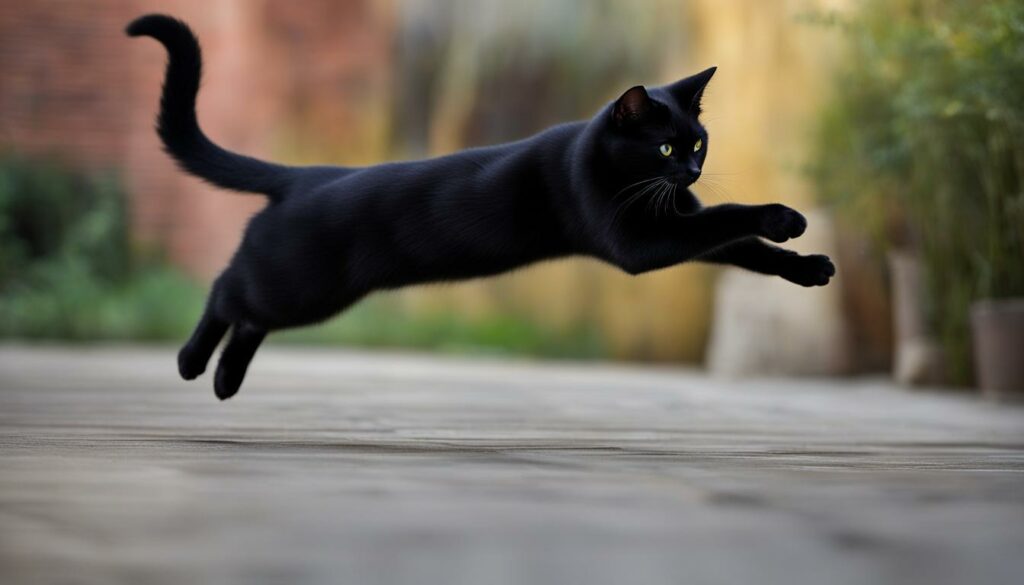
“Cats are the epitome of elegance and grace when it comes to jumping. Their ability to effortlessly defy gravity is truly mesmerizing.” – Cat Lover
The Science of a Cat’s Leap
Cats are natural-born hunters, and their jumping abilities play a crucial role in catching prey. They carefully stalk their target, and when the moment is right, they launch themselves into the air with a powerful pounce, using their hind legs to propel them forward. The spring-like motion allows them to ascend to great heights, giving them the advantage in catching their elusive prey.
With their feline agility and athletic prowess, cats are well-equipped to navigate the challenges of the hunt. Their ability to leap high is driven by their instinctual need to capture and secure prey. As they stalk their target, cats assess the distance and position themselves strategically for the perfect pounce. When they spring into action, their hind legs act as powerful pistons, propelling them forward with remarkable force.
This efficient and precise movement enables cats to reach impressive altitudes and make quick airborne maneuvers. From the moment they launch themselves into the air, their muscles work in perfect synchrony to optimize their ascent. Their front legs extend forward, while their hind legs push off the ground, driving their body upward in a graceful arc. This coordinated motion allows them to effortlessly clear obstacles and secure their prey.
In the words of renowned cat behaviorist Jackson Galaxy, “Cats are the ultimate athletes, and their ability to jump high is a testament to their natural instincts and finely honed hunting skills.”
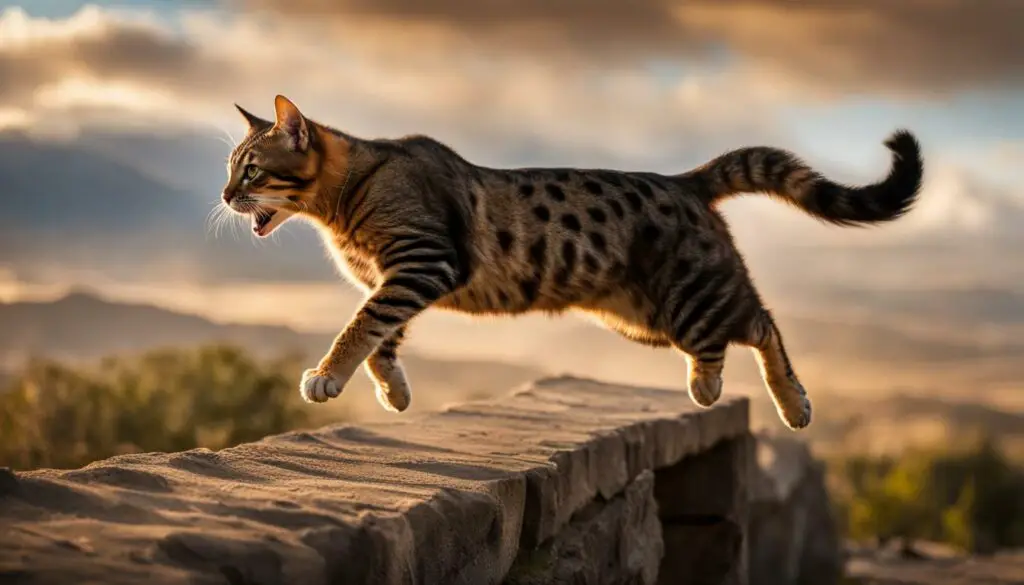
As cats soar through the air, their eyes remain focused on their target, demonstrating their exceptional visual tracking skills. Their acute senses, combined with their agile bodies, enable them to make split-second adjustments to their trajectory mid-jump, ensuring a successful capture. This ability to adapt their movements in real-time is a testament to their remarkable coordination and depth perception.
The Role of Muscle Strength and Flexibility
Behind a cat’s impressive jumping abilities lies a combination of muscle strength and flexibility. Their hind legs are particularly powerful, allowing them to generate the force needed to propel themselves into the air. Meanwhile, their spines are incredibly flexible, providing them with the range of motion necessary for their acrobatic leaps. These physical attributes give cats the ability to execute jumps with precision and grace.
| Physical Attributes | Explanation |
|---|---|
| Muscle Strength | Cats have well-developed leg muscles that enable them to generate explosive power for high jumps. |
| Flexibility | Their flexible spines allow for a greater range of motion, aiding in their ability to adjust their trajectory during a jump. |
| Balance | Cats possess exceptional balance, which helps them maintain stability and land precisely after a jump. |
By understanding the science behind a cat’s leap, we gain a deeper appreciation for their incredible jumping abilities. These agile creatures harness their strength, coordination, and instincts to achieve jaw-dropping heights and capture their prey with awe-inspiring precision.
The Anatomy of a Cat’s Jump
When it comes to the incredible jumping abilities of cats, it all starts with their paws and claws. These unique features play a crucial role in their exceptional jumping skills. A cat’s paws are equipped with sharp claws that provide excellent grip, allowing them to maintain balance during even the highest jumps. Their claws act like tiny anchors, preventing slips and ensuring a secure footing. This precise control over their paws and claws contributes to the grace and agility with which cats navigate their jumps.
But it’s not just their paws and claws that make cats such agile jumpers. Their well-developed sense of balance also plays a significant role. Cats have highly sensitive inner ear structures that help them maintain equilibrium while in mid-air. This innate sense of balance allows them to adjust their bodies and make nimble mid-air corrections, ensuring they land gracefully and without a stumble. Their ability to maintain balance and coordination throughout the jump is truly remarkable and a testament to their natural athleticism.
Additionally, a cat’s jumping prowess is influenced by the intricate coordination between their muscles and limbs. Each muscle group works in harmony to generate the power needed for a successful jump. From the explosive force generated by their hind legs to the precise movements of their tail and body, every part of their anatomy contributes to the fluidity and efficiency of their jumps. This seamless coordination allows cats to execute flawless landings, showcasing their athletic prowess and physical control.
The Perfect Landing
One of the most impressive aspects of a cat’s jump is their ability to land with grace and precision. Cats have an innate sense of timing and spatial awareness that allows them to calculate the perfect landing spot. As they descend from their jump, they carefully analyze their surroundings, adjusting the position of their body to ensure a safe and secure landing. Their incredible proprioception, which refers to their sense of body awareness, allows them to make split-second adjustments and land on their feet with remarkable accuracy.
In conclusion, the anatomy of a cat’s jump is a fascinating combination of their paws, claws, balance, and coordination. These unique characteristics enable cats to perform incredible leaps with agility and grace. Whether they’re navigating obstacles in the wild or simply jumping onto a countertop at home, their innate abilities never cease to amaze. So the next time you witness a cat’s impressive jump, take a moment to appreciate the remarkable anatomy behind their aerial feats.
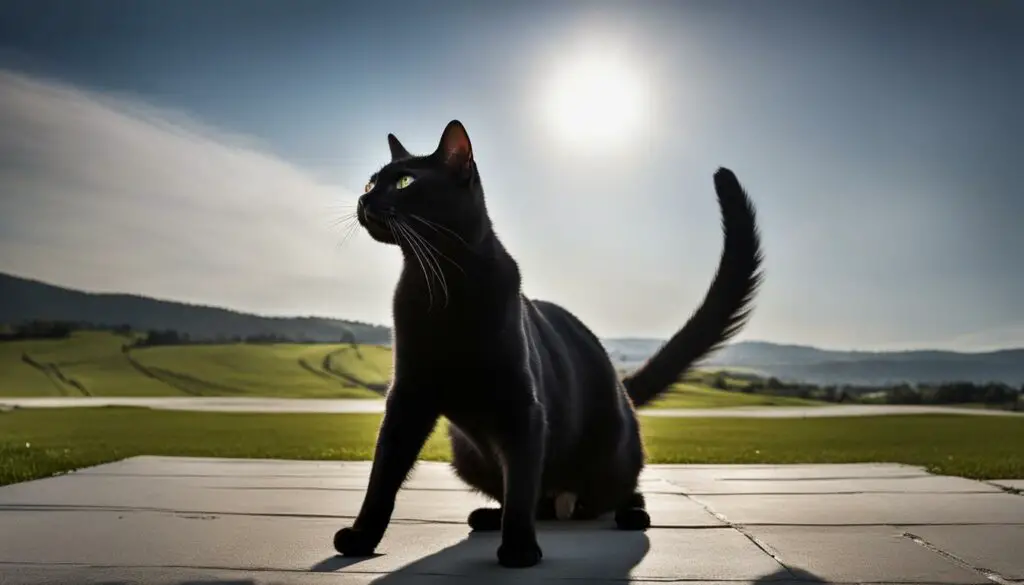
The Height of Cat Jumps
When it comes to aerial leaps, cats are truly in a league of their own. These agile creatures have the remarkable ability to launch themselves into the air with astonishing precision and grace. Whether it’s reaching for a high shelf or effortlessly scaling a wall, cats’ natural instinct for vertical elevation is truly awe-inspiring.
One of the key factors that allows cats to achieve such impressive heights is their ability to use springboards effectively. Cats can leverage various objects in their environment, such as furniture or walls, as launch points to gain even greater elevation during their jumps. This skillful utilization of springboards gives them an added advantage in their pursuit of the sky.
During a jump, a cat goes from being grounded to becoming airborne in a matter of seconds. They use the explosive power generated by their leg muscles to propel themselves upwards with remarkable force. The elevation they achieve is a testament to their exceptional athleticism and the energy they can generate from their hind legs.
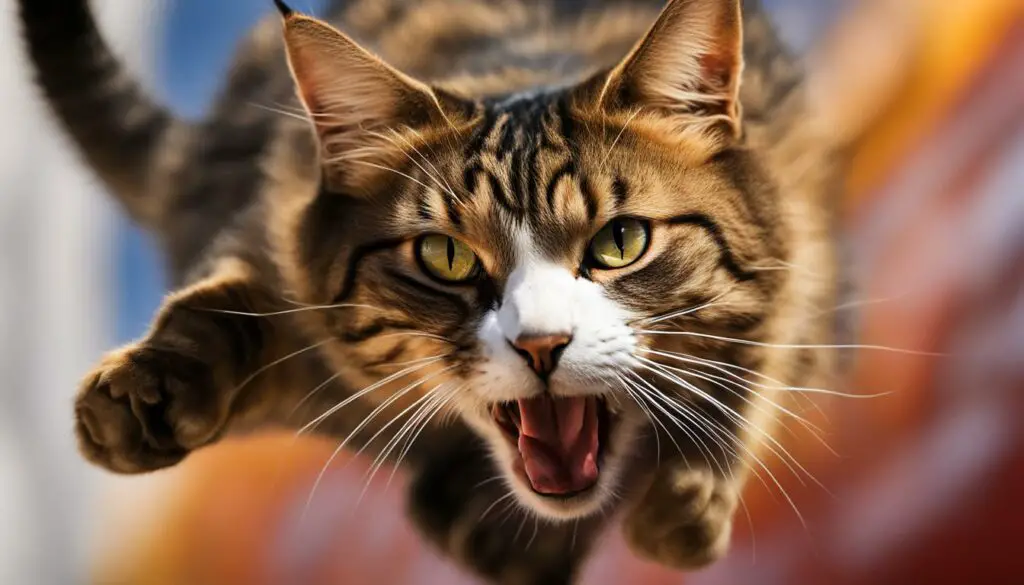
Table: Cat Jumping Height Comparisons
| Breed | Maximum Jump Height (in inches) |
|---|---|
| Abyssinian | 30 |
| Bengal | 32 |
| Maine Coon | 34 |
| Savannah | 36 |
While all cats possess the ability to jump, certain breeds are known for their exceptional jumping skills. Abyssinians, Bengals, Maine Coons, and Savannahs are among the feline breeds that excel in leaping to impressive heights. These athletic cats can reach elevated positions that far exceed their own body lengths, leaving us in awe of their extraordinary abilities.
Feline Olympic Athletes
Cat agility competitions have become increasingly popular in recent years, offering a platform to showcase the impressive skills and athleticism of these incredible feline athletes. These competitions test cats’ agility, speed, dexterity, and reflexes as they navigate through obstacle courses filled with hurdles, tunnels, and other challenges.
Watching these feline Olympic athletes in action is truly awe-inspiring. Their ability to leap over hurdles with precision, maneuver through tight spaces with ease, and react swiftly to changing obstacles is a testament to their exceptional agility and athleticism. These competitions not only highlight the natural jumping abilities of cats but also serve as a reminder of the incredible bond between cats and their human companions.
“Cats are agile, graceful creatures, and agility competitions allow them to showcase their natural talents in a fun and interactive way,” says Dr. Samantha Johnson, a veterinarian specializing in feline behavior. Participating in these competitions can provide both physical and mental stimulation for cats, promoting their overall wellbeing.
For those interested in attending or participating in cat agility competitions, there are various organizations and clubs dedicated to this exciting sport. These events offer a unique opportunity to witness the extraordinary abilities of our feline friends and celebrate their athleticism in a supportive and engaging environment.
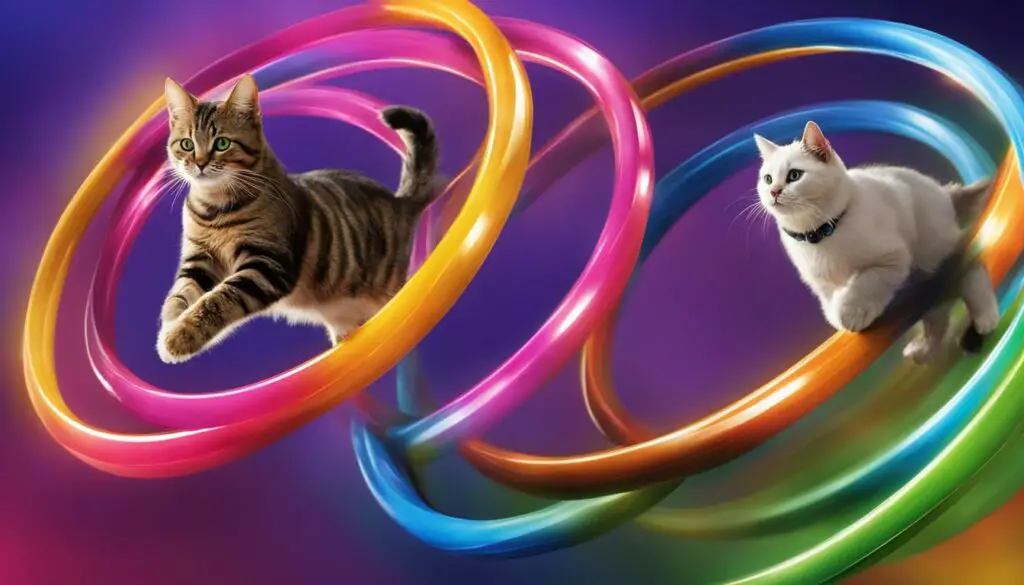
The Joy of Cat Agility Competitions
Watching cats compete in agility competitions brings joy and excitement to spectators. The impressive jumps, swift movements, and clever problem-solving strategies demonstrated by these feline athletes captivate audiences and leave them in awe. These events not only showcase the natural talent and athleticism of cats but also provide a platform for cat lovers to come together and celebrate their shared admiration for these agile creatures.
Cat Breeds Known for High Jumps
When it comes to cat jumping, some breeds are renowned for their exceptional leaping skills. These high-jumping cat breeds are not only athletic but also energetic and sprightly, making them a delight to watch as they effortlessly soar through the air. Let’s take a closer look at some of these remarkable feline athletes.
Abyssinian
The Abyssinian cat is known for its natural agility and athleticism. This breed possesses a lean and muscular body, which allows for powerful jumps and impressive heights. With their boundless energy and playful nature, Abyssinians are always ready to showcase their acrobatic feats.
Bengal
The Bengal cat is a breed that possesses a wild and adventurous spirit. Known for its muscular build and sleek coat, the Bengal is a natural-born jumper. These cats love to explore their surroundings, and their innate athleticism allows them to effortlessly leap to great heights, making them a perfect fit for families seeking an active and agile companion.
Savannah
The Savannah cat is a cross between a domestic cat and the serval, a wild African cat. This hybrid breed inherits the serval’s long legs and excellent jumping ability, resulting in a cat that can achieve remarkable heights with ease. Savannah cats are not only highly energetic but also highly intelligent, making them great companions for those looking for a playful and high-jumping feline friend.
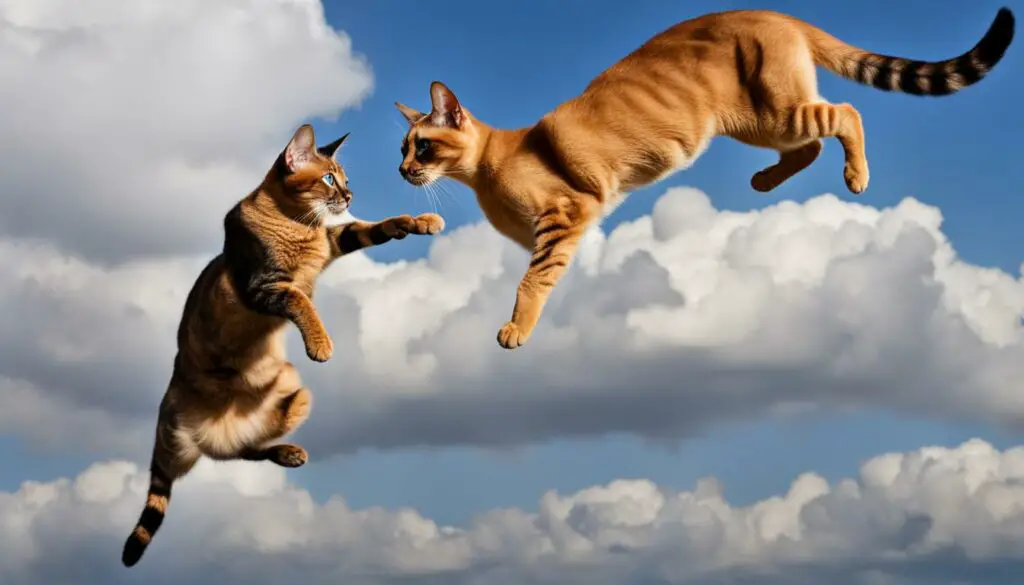
These high-jumping cat breeds are a testament to the extraordinary abilities of our feline friends. Whether it’s the graceful Abyssinian, the adventurous Bengal, or the hybrid Savannah, these cats never fail to leave us in awe with their athletic prowess. From soaring through the air to landing with grace, these feline athletes are truly a sight to behold.
The Evolutionary Advantage of High Jumps
Cats’ incredible jumping abilities, including their capacity to reach impressive heights, are not merely impressive feats of athleticism. These abilities are believed to be an evolutionary adaptation that has provided cats with several advantages in the wild. By being able to reach high places, cats can effectively escape from predators and find safe hiding spots. Additionally, their high-jumping skills enhance their predatory instincts, allowing them to pounce on unsuspecting prey from elevated positions.
The ability to escape predators and reach high places is vital for a cat’s survival in the wild. Cats have evolved to be exceptional jumpers, enabling them to quickly ascend trees, rooftops, or any elevated surface to avoid danger. By gaining the high ground, cats can spot potential threats from a safe vantage point and react accordingly. This evolutionary adaptation greatly improves their chances of survival in their natural habitats.
“Cats’ high-jumping abilities are believed to be an evolutionary adaptation that provides them with several advantages.”
Predatory instincts also play a significant role in a cat’s ability to jump high. By being able to reach elevated positions, cats can effectively ambush their prey. They can observe their surroundings and plan their attacks from advantageous positions, increasing their chances of a successful hunt. Cats’ high-jumping capabilities are a remarkable testament to their evolutionary adaptation and their inherent ability to navigate their environments with both agility and precision.
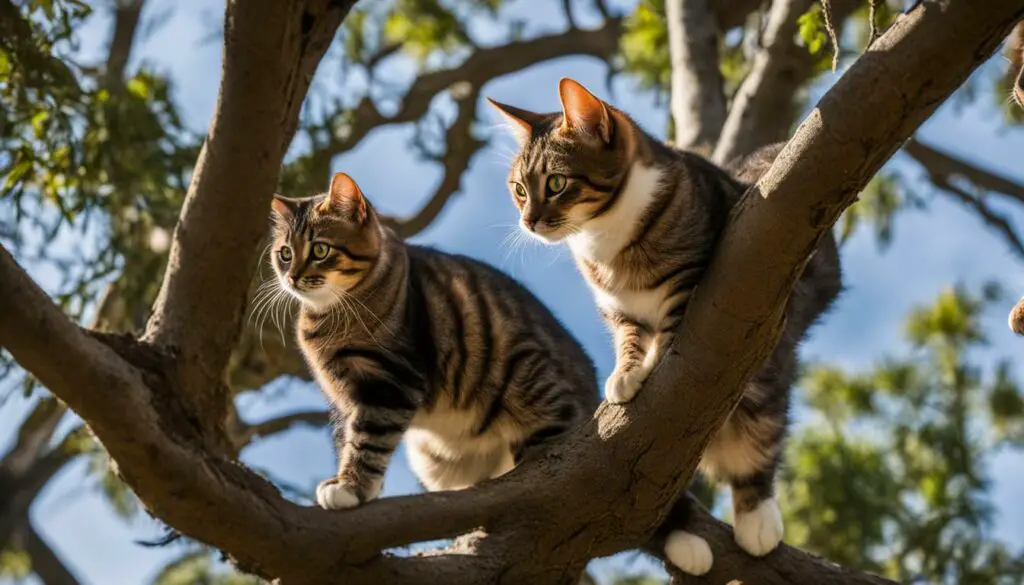
Table: Evolutionary Advantages of High Jumps
| Advantage | Explanation |
|---|---|
| Evasion of Predators | Allows cats to quickly reach elevated positions and escape from potential threats. |
| Surveillance | Enables cats to observe their surroundings, spotting potential prey and dangers. |
| Successful Hunting | Provides cats with an advantage in ambushing prey from elevated positions. |
The evolutionary advantage of high jumps in cats is a testament to their adaptability and survival instincts. Whether in the wild or in our homes, cats’ remarkable ability to jump to great heights showcases their innate athleticism and serves as a reminder of their unique evolutionary journey as agile and nimble creatures.
Captivating Videos of Cats Jumping High
Watching cats jump is an absolute delight, and the internet is filled with captivating videos that showcase their incredible jumping skills. These viral cat videos never fail to impress, leaving viewers in awe of their amazing leaps and bounds. Whether it’s a playful kitten effortlessly jumping across large gaps or a graceful adult cat scaling a wall with ease, these videos highlight the awe-inspiring jumps that cats are capable of.
One of the reasons these videos go viral is the impressive height cats can reach when they jump. From launching themselves into the air to soaring through space, cats display an incredible vertical ability that often exceeds their own body lengths. It’s truly a sight to behold as they defy gravity and momentarily appear weightless. These high jumps are not only visually impressive but also a testament to the strength and power of their agile bodies.
What makes these videos even more captivating is the precision and grace with which cats land after their jumps. Cats have a remarkable ability to adjust their bodies mid-air, ensuring a perfect landing every time. Their keen sense of balance, coordination, and impeccable timing allows them to execute flawless landings, even after performing the most acrobatic of jumps.
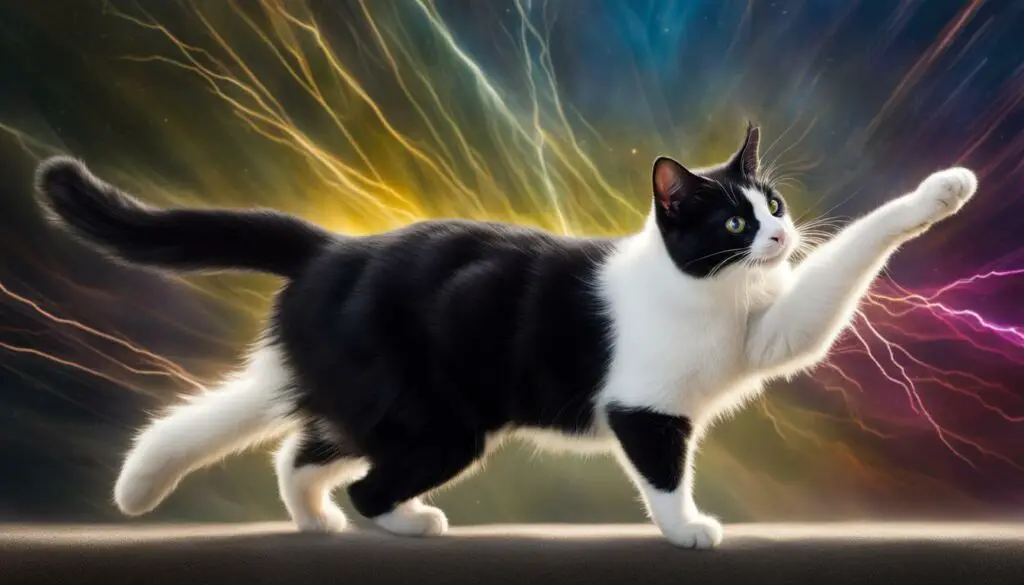
So, next time you come across a viral cat video, take a moment to appreciate the impressive leaps and bounds these feline athletes are capable of. Whether they are jumping for play, exploration, or hunting, cats never cease to amaze us with their awe-inspiring jumps. These videos serve as a reminder of the extraordinary physical abilities and natural agility that our feline companions possess.
Cat Jumping and Exercise
Exercise is essential for keeping cats healthy and engaged. Providing opportunities for vertical movement and encouraging their natural jumping instincts is key to ensuring their physical well-being. By incorporating climbing trees or cat trees into their environment, you can give your feline companion the chance to engage in vertical exploration and exercise.
Active playtime is another great way to promote exercise for cats. Use toys that stimulate jumping, such as feather wands or laser pointers, to encourage your cat to leap and pounce. This type of play not only provides physical activity but also engages their hunting instincts, keeping them mentally stimulated and satisfied.
It’s important to note that not all cats are natural jumpers, and some may require encouragement or training to develop their jumping skills. Patience and positive reinforcement are key when training cats. Start with low obstacles, gradually increasing the difficulty as your cat becomes more confident. Clicker training can be a useful tool to teach cats to jump on command and participate in agility exercises.
Providing Vertical Space
In addition to exercise and training, providing vertical space in your home is crucial for promoting a cat’s natural jumping behavior. Cats love to climb and perch in high places, as it offers them a vantage point to observe their surroundings and feel secure. Installing cat shelves, wall-mounted perches, or cat condos with multiple levels can provide vertical space for your cat to explore and jump to their heart’s content.
Incorporating climbing trees or cat trees into a cat’s environment provides opportunities for vertical movement, encouraging their natural jumping instincts.
Remember, every cat is unique, and their exercise needs may vary. Some cats may be more inclined to jump and play, while others may prefer less physically demanding activities. It’s important to observe your cat’s preferences and tailor their exercise routine accordingly.
| Benefits of Cat Jumping and Exercise |
|---|
| 1. Promotes physical health and fitness |
| 2. Provides mental stimulation and enrichment |
| 3. Engages hunting instincts |
| 4. Helps maintain a healthy weight |
| 5. Creates a bond between you and your cat through interactive play |
By incorporating exercise and providing vertical space for jumping, you can help ensure that your cat leads a happy and healthy life. So, let your feline friend reach new heights and soar through the air with their impressive jumping skills!
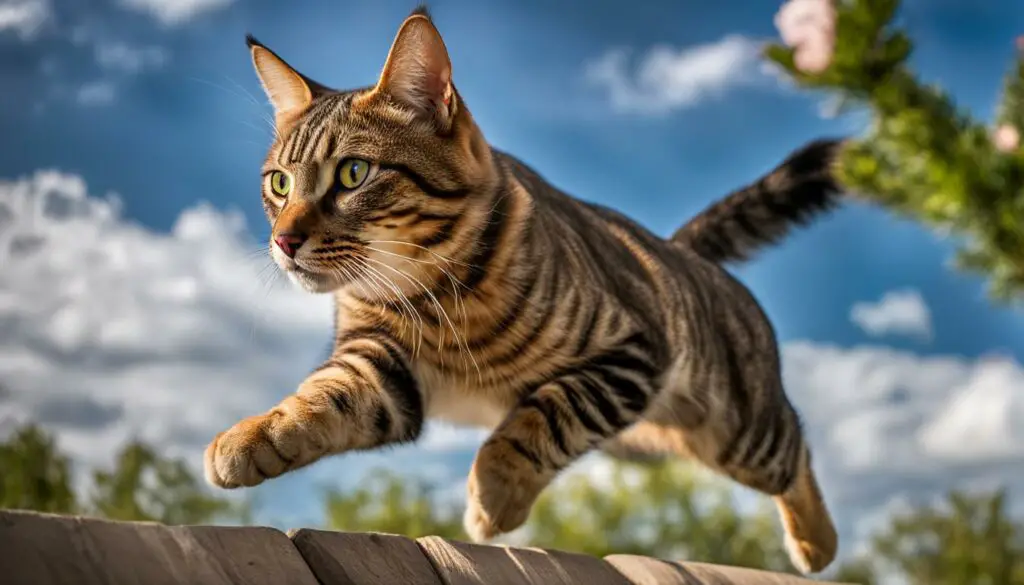
Safety Considerations for Cat Jumping
As much as we marvel at our cats’ impressive jumping abilities, it’s crucial to take safety precautions to protect our feline friends from potential falls and injuries. Here are some important considerations to ensure a safe environment for your cat:
1. Cat-Proofing the Home
To prevent falls, it’s essential to cat-proof your home by securing windows screens and ensuring stable furniture. Cats are naturally curious, and an open window or wobbly piece of furniture can pose a significant danger. Make sure windows are securely screened, and check furniture stability to avoid accidents.
2. Providing Safe Vertical Spaces
Cats love to climb and jump to high places, but it’s crucial to provide safe options for vertical exploration. Invest in sturdy cat trees or shelves that are securely mounted to walls and offer elevated perches where your cat can safely enjoy their jumping instincts. Providing appropriate scratching posts can also redirect their jumping to safe areas of the home.
3. Regular Maintenance and Inspections
Regularly inspect your home for any potential hazards that could compromise your cat’s safety. Check for loose rugs or cords that could cause tripping hazards. Ensure that windows and doors are securely closed, and screens are intact. Keep toxic plants out of reach and secure any potentially dangerous household chemicals.
By taking these safety considerations into account, we can create a secure environment that allows our cats to enjoy their natural jumping instincts while minimizing the risk of falls and injuries. Remember, a happy and healthy cat is a cat that can explore and jump with peace of mind!
Table: Common Safety Considerations for Cat Jumping
| Safety Considerations | Tips |
|---|---|
| Cat-Proofing the Home | Secure windows screens and stabilize furniture |
| Providing Safe Vertical Spaces | Invest in sturdy cat trees or shelves |
| Regular Maintenance and Inspections | Check for potential hazards and toxins |
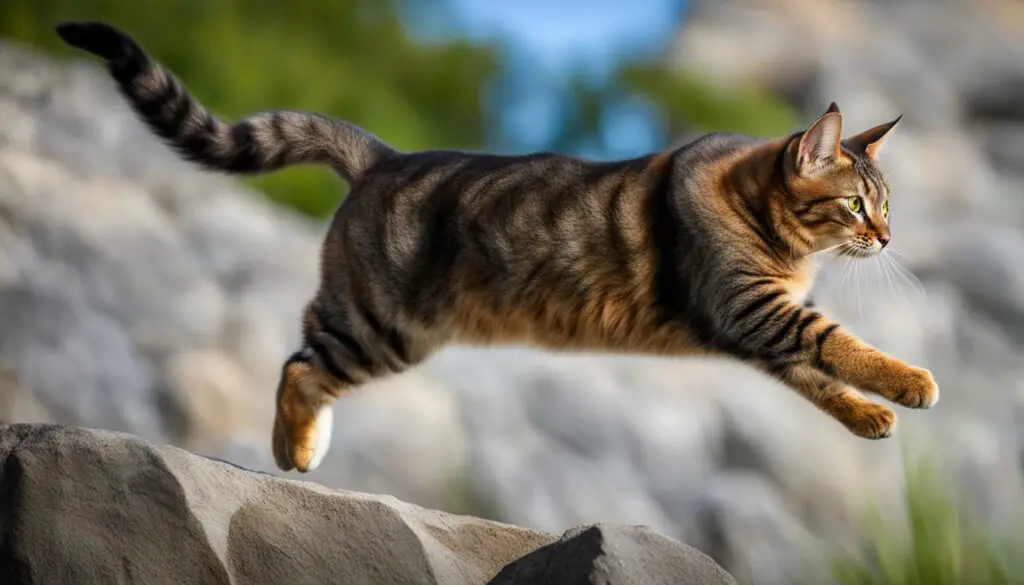
“Safety should always be a top priority when it comes to our furry friends. By taking simple measures to cat-proof our homes and provide safe jumping spaces, we can ensure that our cats can enjoy their natural instincts while minimizing the risk of accidents.”
Training Cats to Jump
Training cats to jump can be a fun and rewarding experience for both you and your feline companion. By using positive reinforcement techniques like clicker training, you can teach your cat agility exercises and jumps. This type of training strengthens the bond between you and your cat while also providing mental and physical stimulation.
Positive reinforcement involves rewarding your cat for desired behavior, such as successfully completing a jump. You can use a clicker, a small handheld device that makes a distinct clicking sound, to mark the exact moment your cat performs the desired action. Immediately after the click, provide a treat or verbal praise to reinforce the behavior.
When training your cat to jump, start with small obstacles or platforms at a low height. Place a treat or toy on the other side to encourage your cat to jump over. As your cat becomes more comfortable and confident, gradually increase the height and difficulty of the obstacles. Remember to always use positive reinforcement and patience, as each cat learns at their own pace.
It’s important to note that not all cats may be interested in training or jumping. Some cats may not have the same level of motivation or desire to participate. If your cat doesn’t seem interested, it’s best to respect their individual preferences and focus on other activities they enjoy. Each cat is unique, and it’s essential to tailor training methods to their specific needs and personality.

Tips for Training Cats to Jump:
- Start with low obstacles and gradually increase the height and difficulty as your cat progresses.
- Use positive reinforcement, such as treats and praise, to reward your cat for successful jumps.
- Be patient and understanding, as each cat learns at their own pace.
- Make training sessions short and fun to keep your cat engaged and interested.
- Always prioritize your cat’s safety and well-being during training exercises.
Important Considerations:
“Training cats to jump requires patience, positive reinforcement, and understanding. It’s essential to respect your cat’s individual preferences and motivations. Remember, training should be a positive experience for both you and your feline companion.”
| Benefits of Training Cats to Jump |
|---|
| Improved agility and coordination |
| Mental and physical stimulation |
| Strengthened bond between you and your cat |
| Opportunity for fun and engaging activities |
The Joy of Watching a Cat Jump
Watching a cat jump is a truly mesmerizing experience. The grace and elegance with which they leap through the air, defying gravity, is a captivating display of their agility and athleticism. Whether it’s a simple jump onto a high surface or an intricate aerial acrobatic performance, cats never fail to impress with their awe-inspiring jumps.
“Cats are the epitome of grace and precision when it comes to jumping. Their leaps are a beautiful combination of strength, flexibility, and coordination. It’s like watching a ballet in mid-air,” says feline behavior expert, Dr. Emily Wilson.
With each jump, cats showcase their remarkable ability to control their body in the air, adjusting their trajectory effortlessly. Their powerful hind legs propel them to great heights, while their keen sense of balance and coordination ensure a smooth landing. Whether they are gracefully leaping from one piece of furniture to another or soaring through obstacle courses, their jumps never fail to captivate and leave us in awe.
“Cats have a natural instinct to explore their environment and test their physical limits. Their jumps are a reflection of their curiosity, playfulness, and innate hunting abilities,” explains Dr. Wilson. “It’s fascinating to observe how they use their jumps to navigate their surroundings and engage their predatory instincts.”
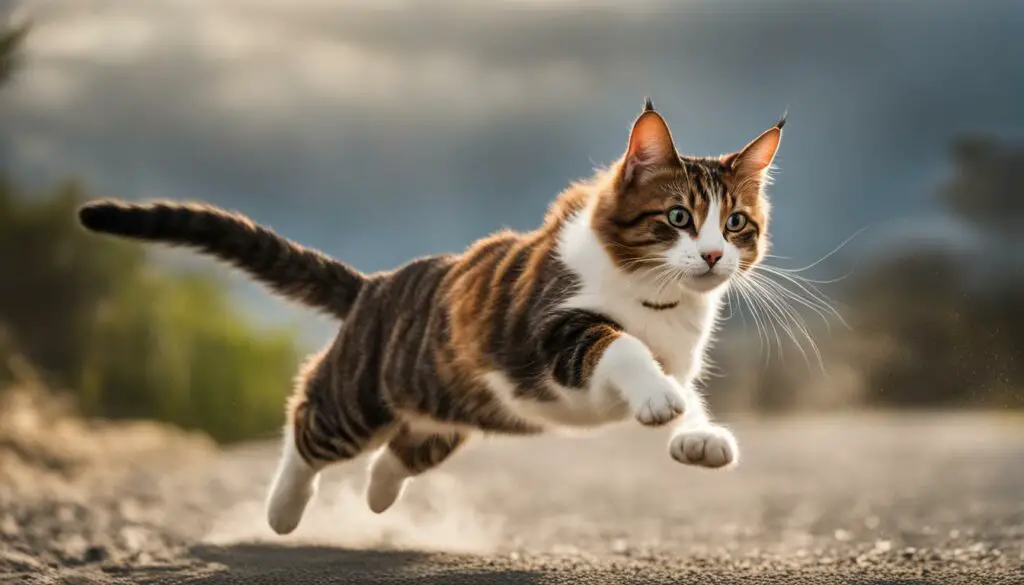
The Art of Precision
What makes cat jumps even more impressive is the precision with which they execute their leaps. Cats have an innate understanding of their surroundings, allowing them to calculate the distance, angle, and timing required to make their jumps with utmost accuracy. This incredible spatial awareness is a testament to their exceptional cognitive abilities.
“Cats are incredibly calculated in their jumps. They take into account the height, distance, and potential obstacles in their path, ensuring they land exactly where they intend to,” says Dr. Wilson. “Their jumps are a beautiful combination of instinct, agility, and intelligence.”
Whether they are jumping for play, hunting, or simply exploring their environment, the artistry and precision of a cat’s leap never fail to leave us captivated. It’s a reminder of the extraordinary capabilities of these incredible animals and the endless fascination they bring to our lives.
The Versatility of Cat Jumps
When we think of cat jumps, we often envision their impressive vertical leaps. But cats’ jumping abilities extend beyond just reaching great heights. These agile creatures also display incredible versatility in their jumping techniques, effortlessly executing both vertical and horizontal jumps with precision and grace.
Vertical jumps are a staple of a cat’s repertoire, allowing them to scale heights that seem unimaginable. Whether it’s leaping onto a high shelf or effortlessly bounding onto countertops, their explosive power and energy generate impressive elevation. These vertical jumps are not only a testament to their athleticism but also serve practical purposes, such as reaching safe vantage points or pouncing on prey from above.
However, cats’ jumping skills aren’t limited to vertical leaps alone. They also excel in horizontal jumps, showcasing their remarkable agility and spatial awareness. Whether it’s darting from one piece of furniture to another or effortlessly navigating complex obstacle courses, cats display a level of versatility that never fails to astound. Their precise landings after these horizontal jumps demonstrate their exceptional coordination and body control, ensuring they gracefully stick the landing every time.
To truly appreciate the versatility of cat jumps, let’s take a closer look at the differences between vertical and horizontal jumps:
| Vertical Jumps | Horizontal Jumps |
|---|---|
| Impressive elevation | Swift and precise trajectory |
| Explosive power from hind legs | Effortless navigation through obstacles |
| Allows access to elevated vantage points | Darts from one point to another |
As cat owners, we are lucky to witness the versatility of their jumps on a daily basis. Whether they’re elegantly launching themselves onto our laps or gracefully leaping from one perch to another, cats’ jumps never cease to amaze. Their combination of vertical and horizontal leaps, along with their precise landings, solidify their status as true acrobats of the animal kingdom.
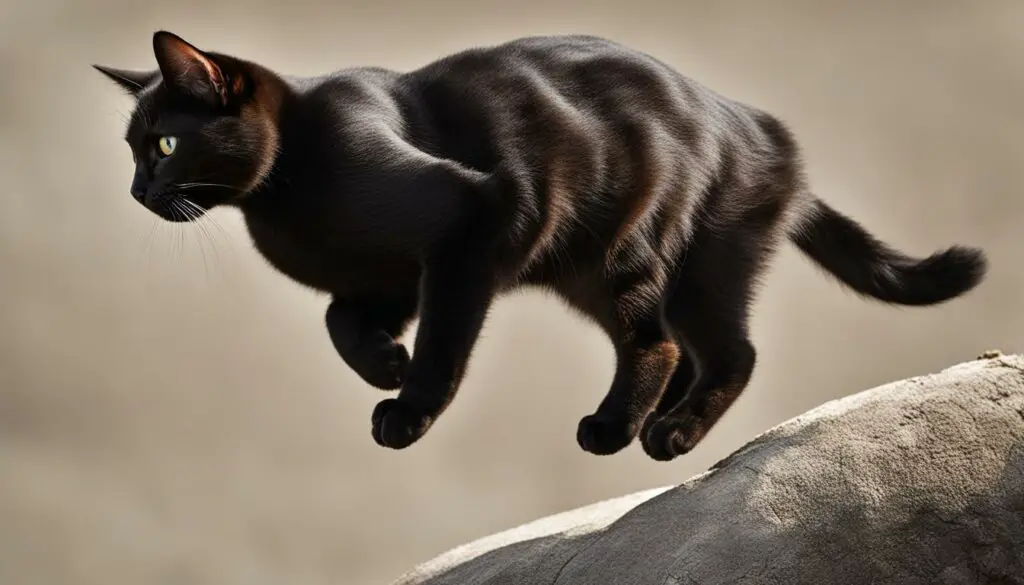
With each jump they make, cats demonstrate their exceptional athleticism, coordination, and natural instincts. Whether they’re soaring through the air with a vertical leap or gracefully gliding from one point to another, their jumps exemplify their adaptability and inherent grace. So the next time you witness your feline companion in mid-air, take a moment to appreciate the versatility of their jumps and the remarkable abilities that make them such incredible creatures.
Conclusion
After delving into the world of cat jumps, it’s clear that feline agility and acrobatics are truly awe-inspiring. Cats possess remarkable athleticism, showcasing their ability to soar to great heights with nimble precision.
The physics behind cat jumping reveals their incredible athletic prowess. With powerful leg muscles and flexible spines, cats generate the force needed to propel themselves into the air and reach impressive altitudes. Their agile bodies allow for mid-jump adjustments, making their jumps even more astonishing.
These high jumps serve a crucial purpose in a cat’s natural instincts. From hunting prey to escaping predators, their spring-like motion and exceptional coordination give them the advantage in catching elusive prey and reaching safe perches.
Whether watching captivating videos or witnessing their jumps firsthand, cat jumping never fails to leave us in awe. Their mesmerizing leaps, graceful landings, and versatility in both vertical and horizontal jumps highlight their acrobatic abilities and make us appreciate the extraordinary talents of our feline companions.
FAQ
What makes cats such great jumpers?
Cats have powerful leg muscles and flexible spines, allowing them to generate force and adjust their trajectory mid-jump, resulting in impressive heights.
How do cats use their jumping skills to catch prey?
Cats use their hind legs to launch themselves into the air, pouncing on prey with a powerful force. Their ability to ascend to great heights gives them an advantage in catching elusive prey.
How do a cat’s paws and claws contribute to their jumping abilities?
Cats’ sharp claws provide excellent grip, helping them maintain balance during jumps. Additionally, their inner ear structures and coordination between muscles and limbs enhance their jumping skills.
How high can cats jump?
Cats can reach astonishing vertical heights, often exceeding their own body lengths. They can also use springboards such as furniture or walls to gain even greater height.
Which cat breeds are known for their high jumping skills?
Abyssinians, Bengals, and Savannah cats are among the feline breeds known for their exceptional jumping abilities and athleticism.
Why do cats have such high jumping abilities?
Cats’ ability to jump high is believed to be an evolutionary adaptation that helps them access safe hiding spots, escape from predators, and pounce on unsuspecting prey from elevated positions.
Are there competitions that showcase cat agility and jumping skills?
Yes, cat agility competitions have gained popularity, where cats navigate obstacle courses, showcasing their speed, dexterity, and lightning-fast reflexes.
How can I encourage my cat’s jumping instincts?
Providing vertical space, such as climbing trees or cat trees, and engaging in active playtime with jumping toys can help stimulate your cat’s natural jumping instincts and keep them physically active.
How can I ensure my cat’s safety while jumping?
Cat-proofing the home by securing window screens and ensuring stable furniture can help prevent falls and injuries. Providing appropriate scratching posts and elevated perches can redirect their jumping instincts to safe areas.
Can cats be trained to jump?
Yes, cats can be trained to jump using positive reinforcement techniques like clicker training. Agility exercises can help them learn to jump on command and participate in fun training sessions.
What makes watching a cat jump so captivating?
The grace, poise, and seemingly effortless way cats leap through the air are mesmerizing. Their jumps showcase their agility, athleticism, and remarkable coordination.
Do cats only jump vertically, or can they jump horizontally too?
Cats demonstrate impressive horizontal jumps as well. Whether it’s navigating furniture or complex obstacle courses, their versatility in jumping techniques is a testament to their exceptional skills.

